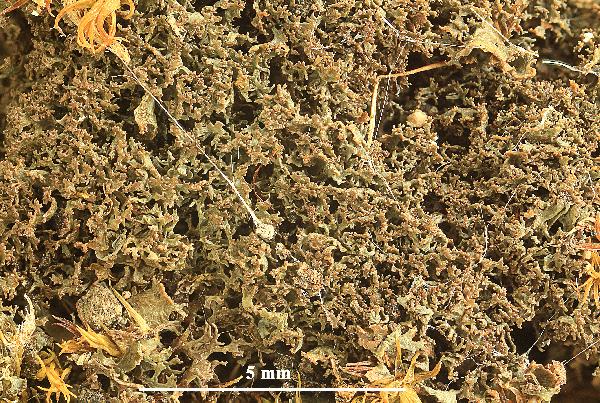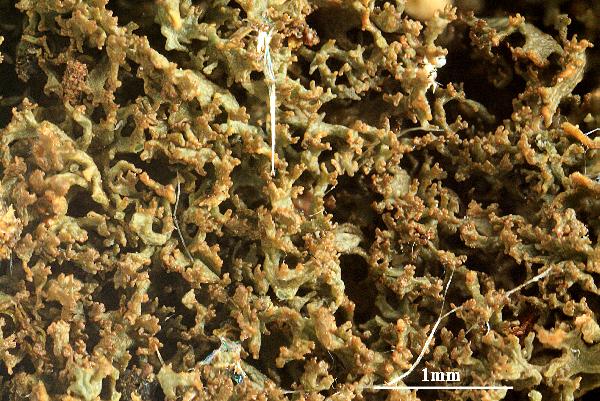Scytinium tenuissimum (Dicks.) Otálora, P.M. Jørg. & Wedin
Fungal Divers., 64, 1: 291, 2013. Basionym: Lichen tenuissimus Dicks. - Fasc. Pl. Crypt. Brit., 1: 12, 1785
Synonyms: Collema atrocoeruleum var. tenuissimum (Hoffm.) Schaer.; Leptogium humosum Nyl.; Leptogium spongiosum (Sm.) Nyl.; Leptogium tenuissimum (Hoffm.) Körb.; Lichen tenuissimus Dicks. nom. illegit.
Distribution: N - Frl, Ven (S-L35787), TAA (Nascimbene & al. 2007b), Lomb, Emil (Fariselli & al. 2020), Piem (Isocrono & al. 2006), Lig. C - Tosc, Umb (Ravera & al. 2006, 2006b), Abr (Caporale & Pagliani 2010, Caporale & al. 2016), Sar (Zedda 2002). S - Camp, Pugl (Nimis & Tretiach 1999), Bas (Potenza & al. 2014), Cal (Puntillo 1996), Si (Nimis & al. 1996b, Ottonello & al. 2011).
Description: Thallus small-squamulose to minutely foliose, subgelatinous when wet, dark brown to blue-grey, often paler bluish grey in the basal, less exposed parts, thin, loosely attached, often forming 1-2 cm wide cushions. Squamules up to 1(-2) mm wide and 80-100 µm thick, slightly elongate, densely imbricate, with strongly dissected margins whose thin divisions tend to become cylindrical-coralloid. Thallus paraplectenchymatous throughout. Apothecia usually abundant and crowded, lecanorine, sessile, strongly constricted at base, 0.5-1.5(-2.5) mm across, with a reddish brown, deeply concave, smooth disc and a smooth to lobulate, sometimes finely hairy thalline margin. Proper exciple thin, euparaplectenchymatous; epithecium brownish; hymenium colourless, I+ blue; paraphyses coherent, mostly simple, c. 1 µm thick at mid-level, the apical cells slightly swollen; hypothecium colourless. Asci 8-spored, narrowly clavate, the apex strongly thickened, the apical dome K/I+ pale blue, with a downwardly projecting K/I+ deep blue tubular structure. Ascospores muriform or submuriform, with 3-7 transverse septa and (0-)1-2-longitudinal septa, hyaline, ellipsoid to subfusiform, thin-walled, (16-)20-30(-36) x 7-15(-17) µm, thin-walled. Photobiont cyanobacterial (Nostoc, the cells in short chains or in clusters). Spot tests: all negative. Chemistry: without lichen substances. Note: on base-rich soil, but also on bark, in the basal parts of old trunks, rarely on base-rich rocks.
Growth form: Squamulose
Substrata: rocks, bark, soil, terricolous mosses, and plant debris
Photobiont: cyanobacteria, filamentous (e.g. Nostoc, Scytonema)
Reproductive strategy: mainly sexual
Commonnes-rarity: (info)
Alpine belt: absent
Subalpine belt: extremely rare
Oromediterranean belt: absent
Montane belt: very rare
Submediterranean belt: rare
Padanian area: absent
Humid submediterranean belt: rare
Humid mediterranean belt: very rare
Dry mediterranean belt: absent
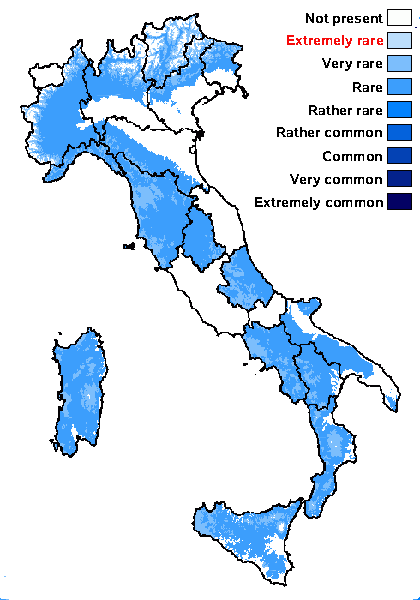
Predictive model
Herbarium samples
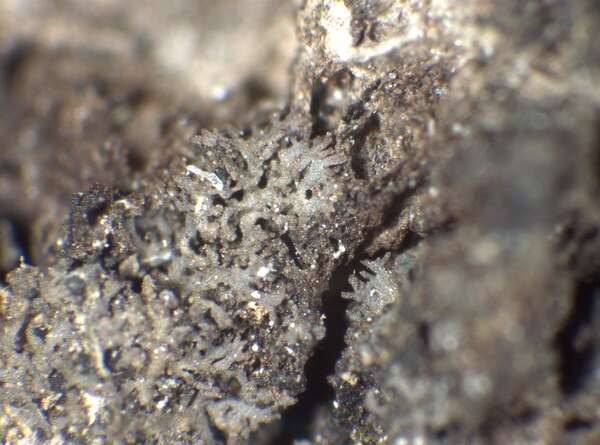

P.L. Nimis; Owner: Department of Life Sciences, University of Trieste
Herbarium: TSB (20129)
2003/03/06
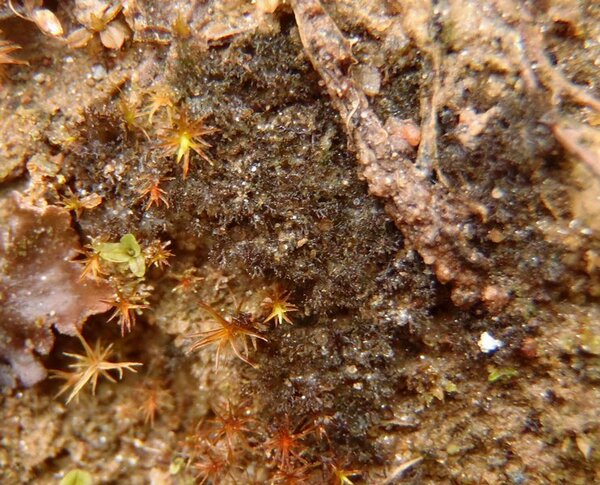

Curtis Randall Björk – CC BY-SA 4.0
British Columbia, Clearwater Valley, Hemp Creek Canyonlands Date: 2012-04-02 On calcareous brecchia cliff in canyon forest
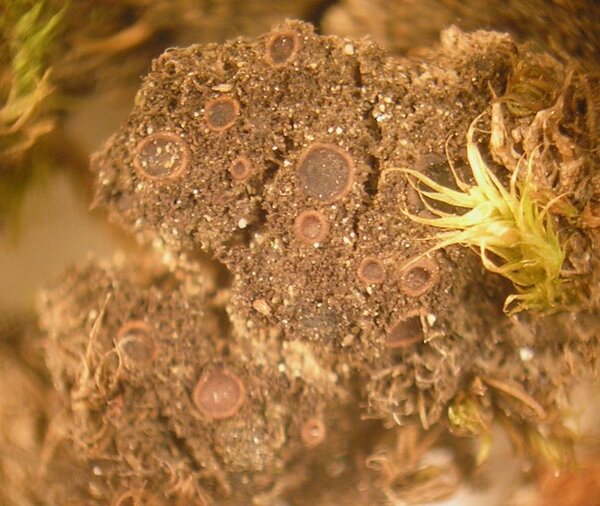

Curtis Randall Björk – CC BY-SA 4.0
British Columbia, Clearwater Valley Date: February, 2011 On soil of tip-up mound in mixed conifer-deciduous forest
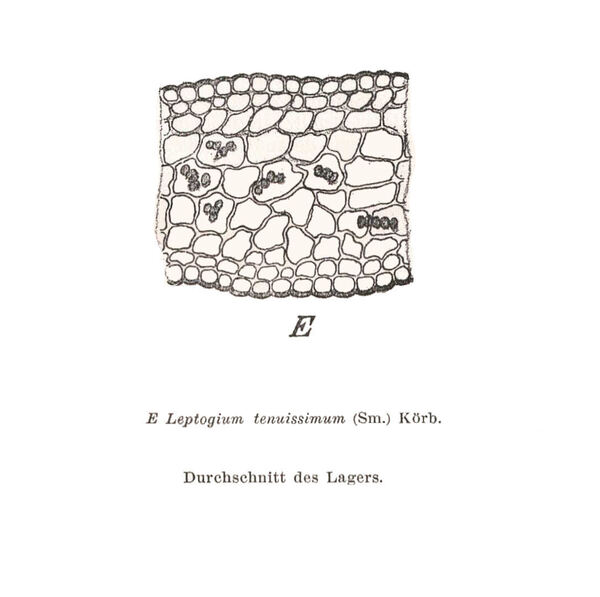
Zahlbruckner A. 1926. Lichenes (Flechten). In: Engler A. (ed.): Die natürlichen Pflanzenfamilien. 2nd ed., vol 8, W. Engelmann, Leipzig, 270 pp.

Courtesy Danièle et Olivier Gonnet - Source: https://www.afl-lichenologie.fr/Photos_AFL/Photos_AFL_S/Scytinium_tenuissimum.htm
France, 6/6/2016 - Névache - Hautes-Alpes

Courtesy Danièle et Olivier Gonnet - Source: https://www.afl-lichenologie.fr/Photos_AFL/Photos_AFL_S/Scytinium_tenuissimum.htm
France, 6/6/2016 - Névache - Hautes-Alpes
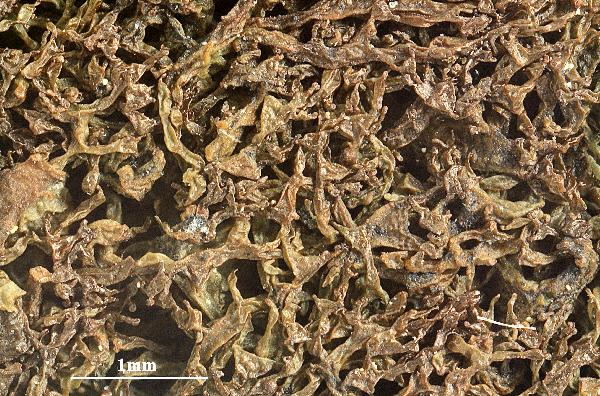

Felix Schumm - CC BY-SA 4.0
[823], Jugoslawien, Sibenik, bei Jadrija, über Moosen zwischen Kalkfelsen.
Leg. F. Schumm, 24.08.1970, det. O. Klement 1970


Felix Schumm - CC BY-SA 4.0
[823], Jugoslawien, Sibenik, bei Jadrija, über Moosen zwischen Kalkfelsen.
Leg. F. Schumm, 24.08.1970, det. O. Klement 1970
Growth form: Squamulose
Substrata: rocks, bark, soil, terricolous mosses, and plant debris
Photobiont: cyanobacteria, filamentous (e.g. Nostoc, Scytonema)
Reproductive strategy: mainly sexual
Commonnes-rarity: (info)
Alpine belt: absent
Subalpine belt: extremely rare
Oromediterranean belt: absent
Montane belt: very rare
Submediterranean belt: rare
Padanian area: absent
Humid submediterranean belt: rare
Humid mediterranean belt: very rare
Dry mediterranean belt: absent

Predictive model
| Herbarium samples |


P.L. Nimis; Owner: Department of Life Sciences, University of Trieste
Herbarium: TSB (20129)
2003/03/06


Curtis Randall Björk – CC BY-SA 4.0
British Columbia, Clearwater Valley, Hemp Creek Canyonlands Date: 2012-04-02 On calcareous brecchia cliff in canyon forest


Curtis Randall Björk – CC BY-SA 4.0
British Columbia, Clearwater Valley Date: February, 2011 On soil of tip-up mound in mixed conifer-deciduous forest

Zahlbruckner A. 1926. Lichenes (Flechten). In: Engler A. (ed.): Die natürlichen Pflanzenfamilien. 2nd ed., vol 8, W. Engelmann, Leipzig, 270 pp.

Courtesy Danièle et Olivier Gonnet - Source: https://www.afl-lichenologie.fr/Photos_AFL/Photos_AFL_S/Scytinium_tenuissimum.htm
France, 6/6/2016 - Névache - Hautes-Alpes

Courtesy Danièle et Olivier Gonnet - Source: https://www.afl-lichenologie.fr/Photos_AFL/Photos_AFL_S/Scytinium_tenuissimum.htm
France, 6/6/2016 - Névache - Hautes-Alpes


Felix Schumm - CC BY-SA 4.0
[823], Jugoslawien, Sibenik, bei Jadrija, über Moosen zwischen Kalkfelsen. Leg. F. Schumm, 24.08.1970, det. O. Klement 1970


 INDEX FUNGORUM
INDEX FUNGORUM
 GBIF
GBIF
 DOLICHENS
DOLICHENS
